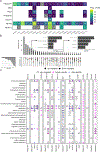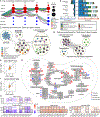The mitochondrial multi-omic response to exercise training across rat tissues
- PMID: 38701776
- PMCID: PMC11152996
- DOI: 10.1016/j.cmet.2023.12.021
The mitochondrial multi-omic response to exercise training across rat tissues
Abstract
Mitochondria have diverse functions critical to whole-body metabolic homeostasis. Endurance training alters mitochondrial activity, but systematic characterization of these adaptations is lacking. Here, the Molecular Transducers of Physical Activity Consortium mapped the temporal, multi-omic changes in mitochondrial analytes across 19 tissues in male and female rats trained for 1, 2, 4, or 8 weeks. Training elicited substantial changes in the adrenal gland, brown adipose, colon, heart, and skeletal muscle. The colon showed non-linear response dynamics, whereas mitochondrial pathways were downregulated in brown adipose and adrenal tissues. Protein acetylation increased in the liver, with a shift in lipid metabolism, whereas oxidative proteins increased in striated muscles. Exercise-upregulated networks were downregulated in human diabetes and cirrhosis. Knockdown of the central network protein 17-beta-hydroxysteroid dehydrogenase 10 (HSD17B10) elevated oxygen consumption, indicative of metabolic stress. We provide a multi-omic, multi-tissue, temporal atlas of the mitochondrial response to exercise training and identify candidates linked to mitochondrial dysfunction.
Keywords: HSD17B10; acetylome; aerobic; exercise; metabolism; metabolomics; mitochondria; multi-omics; proteomics; transcriptomics.
Copyright © 2023 The Authors. Published by Elsevier Inc. All rights reserved.
Conflict of interest statement
Declaration of interests S.C.B. has equity in Emmyon, Inc. S.B.M. is a consultant for BioMarin, MyOme, and Tenaya Therapeutics. M.J.W. serves as a consultant for Arch Venture Partners (AVP) and Bristol Myers Squibb, Inc. E.A.A. is a founder of Personalis, Inc, DeepCell, Inc, and Svexa Inc., a founding advisor of Nuevocor, a non-executive director at AstraZeneca, and an advisor to SequenceBio, Novartis, Medical Excellence Capital, and Foresite Capital. D.A. is employed at Insitro, South San Francisco, CA 94080. N.R.G. is employed at 23andMe, Sunnyvale, CA 94086. P.M.J.B. is employed at Pfizer, Cambridge, MA 02139. Insitro, 23andMe, and Pfizer had no involvement in the design or implementation of the work presented here.
Figures







Update of
-
The mitochondrial multi-omic response to exercise training across tissues.bioRxiv [Preprint]. 2023 Jan 13:2023.01.13.523698. doi: 10.1101/2023.01.13.523698. bioRxiv. 2023. Update in: Cell Metab. 2024 Jun 4;36(6):1411-1429.e10. doi: 10.1016/j.cmet.2023.12.021. PMID: 36711881 Free PMC article. Updated. Preprint.
References
-
- Kluck RM, Bossy-Wetzel E, Green DR, and Newmeyer DD (1997). The release of cytochrome c from mitochondria: a primary site for Bcl-2 regulation of apoptosis. Science 275, 1132–1136. - PubMed
-
- Mootha VK, Bunkenborg J, Olsen JV, Hjerrild M, Wisniewski JR, Stahl E, Bolouri MS, Ray HN, Sihag S, Kamal M, et al. (2003). Integrated analysis of protein composition, tissue diversity, and gene regulation in mouse mitochondria. Cell 115, 629–640. - PubMed
-
- Kappler L, Hoene M, Hu C, von Toerne C, Li J, Bleher D, Hoffmann C, Böhm A, Kollipara L, Zischka H, et al. (2019). Linking bioenergetic function of mitochondria to tissue-specific molecular fingerprints. Am. J. Physiol. Endocrinol. Metab 317, E374–E387. - PubMed
MeSH terms
Grants and funding
- P30 DK048520/DK/NIDDK NIH HHS/United States
- U01 AR071158/AR/NIAMS NIH HHS/United States
- U01 AG070959/AG/NIA NIH HHS/United States
- U24 DK112340/DK/NIDDK NIH HHS/United States
- S10 OD026880/OD/NIH HHS/United States
- U01 AG070928/AG/NIA NIH HHS/United States
- U24 EB023674/EB/NIBIB NIH HHS/United States
- U24 DK112341/DK/NIDDK NIH HHS/United States
- P30 AG044271/AG/NIA NIH HHS/United States
- P20 GM144269/GM/NIGMS NIH HHS/United States
- U24 OD026629/OD/NIH HHS/United States
- U24 DK112342/DK/NIDDK NIH HHS/United States
- U24 DK112331/DK/NIDDK NIH HHS/United States
- T32 DK128770/DK/NIDDK NIH HHS/United States
- U24 AR071113/AR/NIAMS NIH HHS/United States
- U24 DK112348/DK/NIDDK NIH HHS/United States
- U24 OD036598/OD/NIH HHS/United States
- U01 AG055133/AG/NIA NIH HHS/United States
- S10 OD030463/OD/NIH HHS/United States
- U24 DK112349/DK/NIDDK NIH HHS/United States
- U01 AR071150/AR/NIAMS NIH HHS/United States
- P30 DK020572/DK/NIDDK NIH HHS/United States
- U24 DK112326/DK/NIDDK NIH HHS/United States
LinkOut - more resources
Full Text Sources
Miscellaneous

